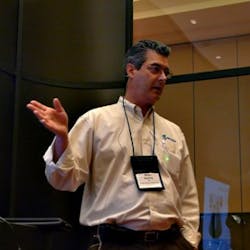Greenhouse Gases Have New Meaning With Algae-based Oil Production
Development requires the gathering of data on growing conditions, sunlight, tank agitation and dozens of other parameters. "That's where Wonderware comes in," Downing said in a theater presentation Tuesday evening. "Because of limited budgeting, SGI needed to get maximum value from its experimental infrastructures. But the system had to be scalable to meet changing capacities at the greenhouse, and it had to have flexible communications, because sensors and inputs move from tank to tank during the course of experimentation."
"The power of Historian in Wonderware gives SGI the data collection and data density capabilities they need to perform critical analysis on product yields and process performance," Downing said. "Wonderware licensing can easily be expanded to accommodate additional processes; this give SGI the flexibility they need."
The Wonderware system also enables staff at partner ExxonMobil's offices to have remote access to the data and be able to monitor the performance. In addition, DLT&V uses a second remote access to give SGI continued support.
Communications are handled wirelessly, bypassing the need to string and re-string wires when data sensors are moved to new tanks. "Budgeting prevented truly industrial wireless," Downing said, "so we opted for consumer transmitters sourced at a local computer gaming store."

